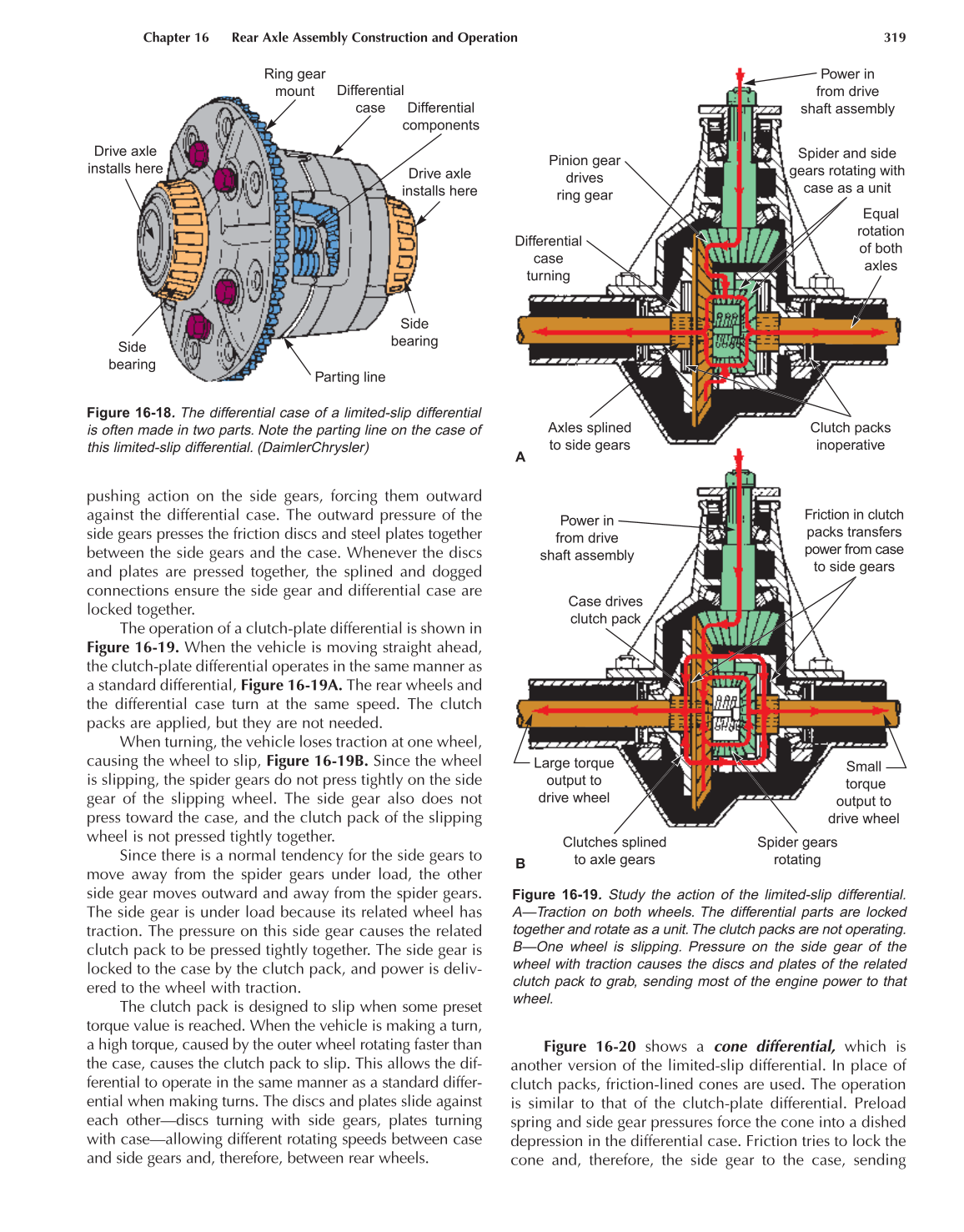pushing action on the side gears, forcing them outward
against the differential case. The outward pressure of the
side gears presses the friction discs and steel plates together
between the side gears and the case. Whenever the discs
and plates are pressed together, the splined and dogged
connections ensure the side gear and differential case are
locked together.
The operation of a clutch-plate differential is shown in
Figure 16-19. When the vehicle is moving straight ahead,
the clutch-plate differential operates in the same manner as
a standard differential, Figure 16-19A. The rear wheels and
the differential case turn at the same speed. The clutch
packs are applied, but they are not needed.
When turning, the vehicle loses traction at one wheel,
causing the wheel to slip, Figure 16-19B. Since the wheel
is slipping, the spider gears do not press tightly on the side
gear of the slipping wheel. The side gear also does not
press toward the case, and the clutch pack of the slipping
wheel is not pressed tightly together.
Since there is a normal tendency for the side gears to
move away from the spider gears under load, the other
side gear moves outward and away from the spider gears.
The side gear is under load because its related wheel has
traction. The pressure on this side gear causes the related
clutch pack to be pressed tightly together. The side gear is
locked to the case by the clutch pack, and power is deliv-
ered to the wheel with traction.
The clutch pack is designed to slip when some preset
torque value is reached. When the vehicle is making a turn,
a high torque, caused by the outer wheel rotating faster than
the case, causes the clutch pack to slip. This allows the dif-
ferential to operate in the same manner as a standard differ-
ential when making turns. The discs and plates slide against
each other—discs turning with side gears, plates turning
with case—allowing different rotating speeds between case
and side gears and, therefore, between rear wheels.
Figure 16-20 shows a cone differential, which is
another version of the limited-slip differential. In place of
clutch packs, friction-lined cones are used. The operation
is similar to that of the clutch-plate differential. Preload
spring and side gear pressures force the cone into a dished
depression in the differential case. Friction tries to lock the
cone and, therefore, the side gear to the case, sending
Chapter 16 Rear Axle Assembly Construction and Operation 319
Drive axle
installs here
Ring gear
mount
Differential
case Differential
components
Drive axle
installs here
Side
bearing
Parting line
Side
bearing
Figure 16-18. The differential case of a limited-slip differential
is often made in two parts. Note the parting line on the case of
this limited-slip differential. (DaimlerChrysler)
Differential
case
turning
Pinion gear
drives
ring gear
Power in
from drive
shaft assembly
Spider and side
gears rotating with
case as a unit
Equal
rotation
of both
axles
Clutch packs
inoperative
Axles splined
to side gears
Power in
from drive
shaft assembly
Case drives
clutch pack
Large torque
output to
drive wheel
Clutches splined
to axle gears
Spider gears
rotating
Small
torque
output to
drive wheel
Friction in clutch
packs transfers
power from case
to side gears
A
B
Figure 16-19. Study the action of the limited-slip differential.
A—Traction on both wheels. The differential parts are locked
together and rotate as a unit.The clutch packs are not operating.
B—One wheel is slipping. Pressure on the side gear of the
wheel with traction causes the discs and plates of the related
clutch pack to grab, sending most of the engine power to that
wheel.
